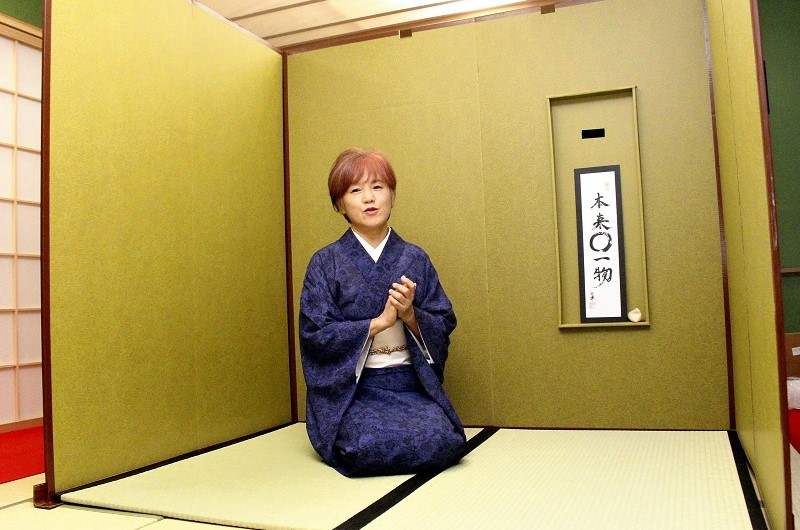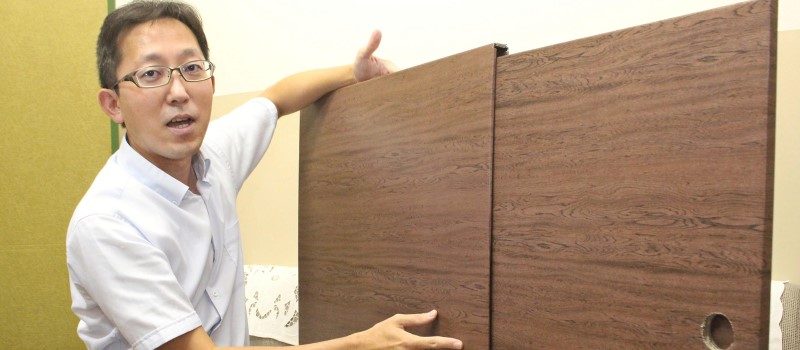Teacher creates cardboard tea room to perform tea ceremony at home

Sachi Okochi sits in a cardboard tea room in Taito Ward, Tokyo.
6:00 JST, September 27, 2022
A woman in Taito Ward, Tokyo, who manages a Japanese tea ceremony classroom has created a cardboard version of a tea room in a bid to have people experience the charm of performing the tea ceremony at home to soothe nerves frayed by the pandemic.
The woman was supported by the spirit of monozukuri, or local people’s craftsmanship, that has long persisted in the traditional commercial and residential areas in Tokyo.
In the about two-tatami mat-sized tea room surrounded on all sides by 1.6-meter-high walls, hanging scrolls add elegance to the space and the rich aroma of incense wafts in the air.
Chashitsu (Tea room) Zero, designed by Senshinan Tea Ceremony Class in the ward, is made entirely of cardboard, except for the Japanese-paper ceiling and tatami mats. There is also a nijiriguchi sliding crawl-in doorway.
“Once inside, you can relax and reset your mind,” said Sachi Okochi, 59, who runs the classroom. “Even though it’s made of cardboard, this is no different from a real tea room.”
Ironically, the prolonged pandemic spurred the creation. Okochi came up with the idea last autumn after students said her tea room was relaxing and wanted to experience it at home.
She contacted Hironosuke Ishikawa, 42, a senior managing director at Ishikawa Paper Co., a paper wholesaler in Sumida Ward, Tokyo, who knows one of Okochi’s students.
A major challenge was to re-create the sophisticated look of a tea room using cardboard while maintaining its strength.
Ishikawa, who has worked in the paper industry for many years, decided to use a cardboard folding screen made by Tanoguchi Shiki, a paper package manufacturer based in Kawaguchi, Saitama Prefecture, because it is sturdy and can be used as a wall when linked together.
The design was entrusted to Masuda Package Industrial Co. based in Echizen, Fukui Prefecture, because the company has the technology to make complex 3D cardboard products such as Buddhist Altars and merchandise shelving.
The walls made by Tanoguchi Shiki were sent to Masuda Package Industrial, and Ishikawa went to Echizen to create a design. He had a particularly difficult time constructing the nijiriguchi doorway, but after nearly 10 attempts, he devised a way to build a sliding door from a thin box glued to a wall of the structure.
The prototype was completed in February. However, as Ishikawa says, “Paper is a living thing,” and it took six months for the project to be completed because the walls warped each time a prototype was created. They needed to be strengthened, and the tatami mats needed to be filled in to prevent gaps.
The tatami mats were made by Morita Tatami Mat Maker in Arakawa Ward, Tokyo, which receives inquiries from foreign countries, too.
“It’s been a lot of trial and error, but I’m relieved the project is done,” Ishikawa said. “I’m happy to help spread traditional Japanese culture.”

Hironosuke Ishikawa of Ishikawa Paper Co. holds a sample of a nijiriguchi sliding doorway.
Tea ceremony culture to world
Okochi plans to go beyond domestic sales and make the tea room available internationally.
Partly because washoku Japanese cuisine was added to the UNESCO Intangible Cultural Heritage list in 2013, the popularity of the tea ceremony is reportedly growing overseas as well.
The Urasenke, one of the San-Senke, or three chanoyu tea ceremony schools of the Sen family that trace their origins back to tea master Sen no Rikyu (1522-1591), held an event from September 2020 to April 2021 in which members of the school living in 36 countries and regions posted videos online of themselves making tea in a relay format.
Even in the middle of the coronavirus pandemic, the tea ceremony is spreading around the world.
Okochi has held tea ceremony and kimono-wearing classes with foreign students, and she was surprised to find out that foreign students know more about the history of such things as the tea ceremony than Japanese students do.
“The cardboard tea room can also be used as a place to meditate or work remotely,” Okochi said. “I want foreigners to know how good a tea room is, and I want to tell the world about the charm of the tea ceremony.”
The cardboard tea room is ¥180,000 for one room. A crowdfunding site in the United States also offers tatami mats, hanging scrolls and incense, in addition to the tea room, depending on the amount invested.
"Society" POPULAR ARTICLE
JN ACCESS RANKING







